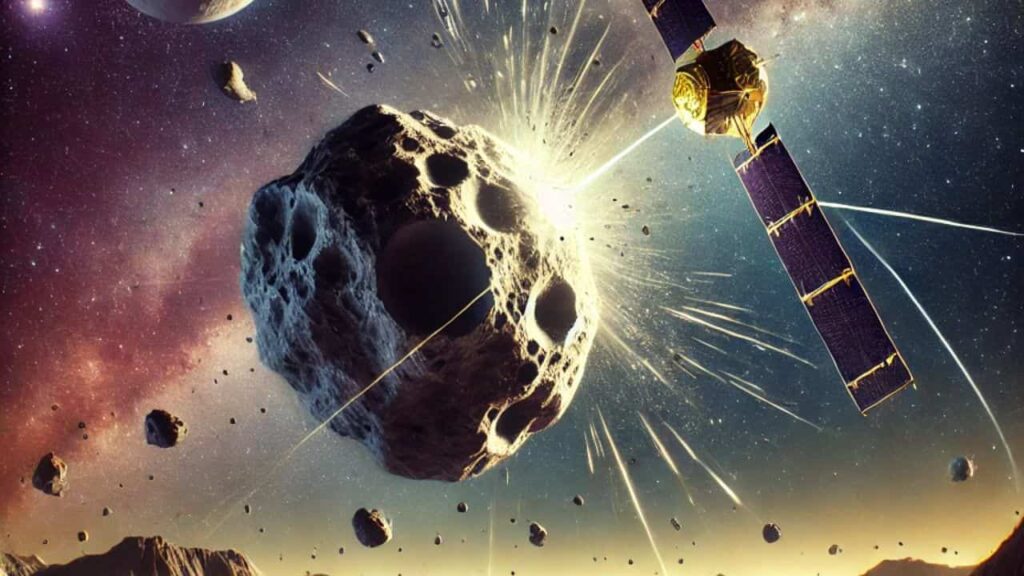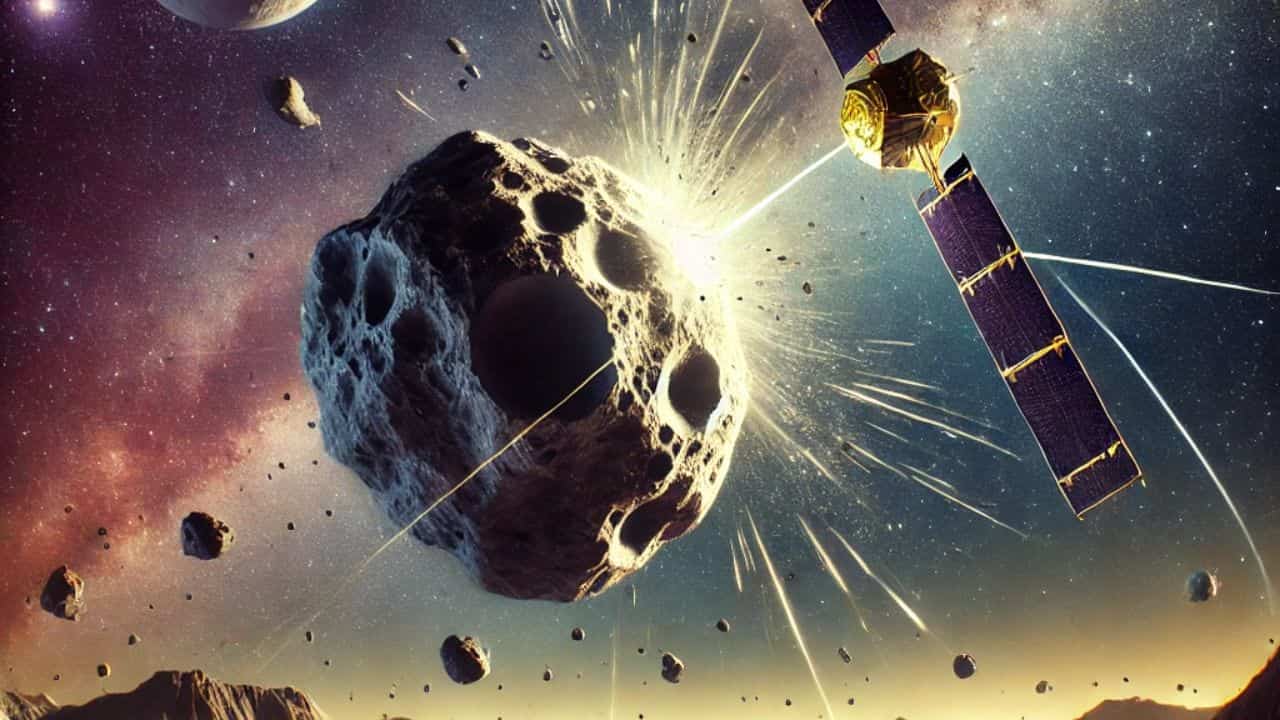NASA DART mission, Dimorphos, Didymos, binary asteroid system, asteroid collision, planetary defense, asteroid redirection, space exploration, asteroid geology, NASA research
Discover the groundbreaking findings from NASA’s DART mission, which successfully collided with the asteroid moonlet Dimorphos. Explore the new insights on the binary asteroid system Didymos and Dimorphos, including their origins, geological characteristics, and the mission’s impact on planetary defense strategies. Learn how this mission advances our understanding of near-Earth objects and the history of our Solar System.

NASA’s DART Mission Sheds New Light on Target Binary Asteroid System
In 2022, NASA’s Double Asteroid Redirection Test (DART) mission made headlines by successfully sending a spacecraft to collide intentionally with Dimorphos, a moonlet asteroid. This mission was a part of a broader effort to study the binary asteroid system comprising Dimorphos and its parent asteroid, Didymos. Recently, the DART mission’s science team has published five insightful papers in Nature Communications, revealing crucial information about the origins, evolution, and physical characteristics of these asteroids. These findings not only enhance our understanding of near-Earth objects but also offer valuable insights into the history of our Solar System.
The Binary Asteroid System: Didymos and Dimorphos
The DART mission focused on the binary asteroid system consisting of Didymos and Dimorphos. Didymos is the larger of the two, while Dimorphos, its smaller companion, is thought to have spun off from Didymos during a mass shedding event. This theory is supported by observations from DART and its accompanying LICIACube cubesat, provided by the Italian Space Agency (ASI). The images captured show a stark contrast between the topographies of the two asteroids. Didymos exhibits smoother surfaces at lower elevations with rocky features and more craters at higher elevations. In contrast, Dimorphos displays a varied topography with boulders of different sizes scattered across its surface.
Geological Insights and Surface Characteristics
The geological analysis of Didymos and Dimorphos, led by Olivier Barnouin and Ronald-Louis Ballouz of Johns Hopkins Applied Physics Laboratory (APL), sheds light on the physical characteristics and surface materials of these asteroids. The study suggests that both asteroids have relatively weak surface characteristics. Didymos is estimated to have a surface age of 12.5 million years, whereas Dimorphos is much younger, with a surface age of less than 300,000 years. This significant age difference implies that Dimorphos has undergone fewer space weathering processes, making it more susceptible to impact-induced changes.
The mission’s data reveals that natural processes can accelerate the spins of small asteroids, leading to material shedding. This phenomenon might have contributed to the formation of Dimorphos from Didymos. The weak surface strength of Dimorphos likely played a crucial role in DART’s success in altering its orbit, demonstrating the potential effectiveness of asteroid redirection strategies.
Formation and Evolution of Dimorphos
Maurizio Pajola and his team from the National Institute for Astrophysics (INAF) in Rome analyzed the shapes, sizes, and distribution patterns of boulders on both asteroids. Their findings indicate that Dimorphos likely formed from materials shed by Didymos, supporting the theory that some binary asteroid systems originate from remnants of a larger primary asteroid. This formation process highlights the dynamic nature of asteroid systems and their ability to evolve over time.
Thermal fatigue, a process where material weakens and cracks due to temperature fluctuations, was also observed on Dimorphos. This phenomenon, studied by Alice Lucchetti and her colleagues at INAF, suggests that surface lines and cracks can develop more rapidly than previously thought. The DART mission provided a unique opportunity to observe this process in real-time, offering valuable data on the physical characteristics of asteroids like Dimorphos.
Bearing Capacity and Surface Response
Understanding the bearing capacity of an asteroid’s surface is crucial for predicting its response to external forces, such as a spacecraft impact. A paper led by students Jeanne Bigot and Pauline Lombardo, supervised by researcher Naomi Murdoch of ISAE-SUPAERO in Toulouse, France, determined that Didymos’ surface has a bearing capacity at least 1,000 times lower than that of dry sand on Earth or lunar soil. This finding underscores the importance of considering surface properties when planning asteroid deflection missions.
Comparative Analysis with Other Asteroids
Colas Robin and his team at ISAE-SUPAERO compared the boulders on Dimorphos with those on other rubble pile asteroids, such as Itokawa, Ryugu, and Bennu. Their research revealed that the boulders share similar characteristics, suggesting a common formation and evolution process for these types of asteroids. The elongated nature of the boulders around the DART impact site implies that they were likely formed through impact processing, further validating the efficacy of the DART mission.
Implications for Future Missions and Planetary Defense
The insights gained from the DART mission provide a more comprehensive understanding of the Didymos system’s origins and evolution. As the European Space Agency’s (ESA) Hera mission prepares to revisit the DART collision site in 2026, these findings will serve as a foundation for further analysis. Hera’s mission aims to examine the aftermath of DART’s impact in greater detail, contributing to our knowledge of planetary defense strategies.
The DART mission was managed by Johns Hopkins APL for NASA’s Planetary Defense Coordination Office and supported by several NASA centers, including the Jet Propulsion Laboratory, Goddard Space Flight Center, Johnson Space Center, Glenn Research Center, and Langley Research Center. This collaborative effort underscores the importance of international cooperation in advancing planetary defense capabilities.
Conclusion
NASA’s DART mission has significantly advanced our understanding of binary asteroid systems, particularly Didymos and Dimorphos. The mission’s success in altering Dimorphos’ orbit provides valuable data for future planetary defense strategies. The geological insights, surface characteristics, and formation processes revealed by the DART mission offer a new perspective on the dynamic nature of asteroids and their role in the Solar System’s history. As we continue to explore and study these celestial bodies, the knowledge gained from missions like DART will be instrumental in safeguarding our planet from potential asteroid threats.
Read More
- NASA Ends VIPER Project: A New Direction for Moon Exploration
- NASA Releases Groundbreaking 2024 Civil Space Shortfall Ranking
- NASAs 2024 Civil Space Shortfall Ranking: Addressing Critical Technology Gaps for Future Exploration
- NASA Hubble Unveils Strong Evidence for Intermediate-Mass Black Hole in Omega Centauri










